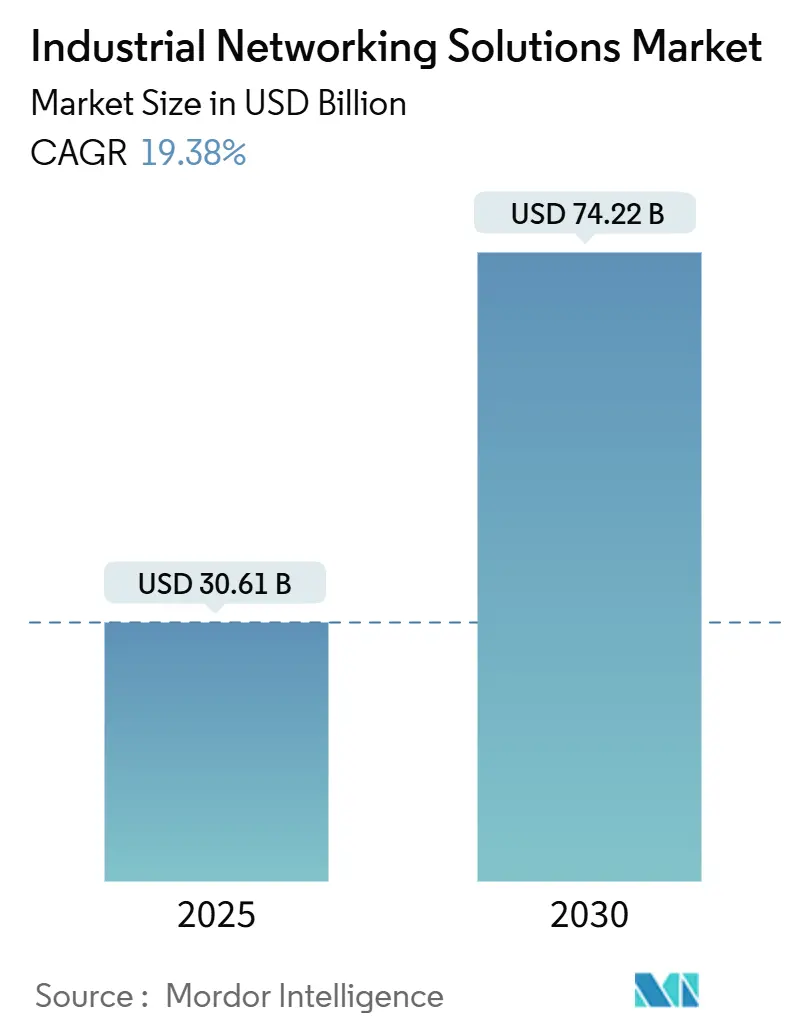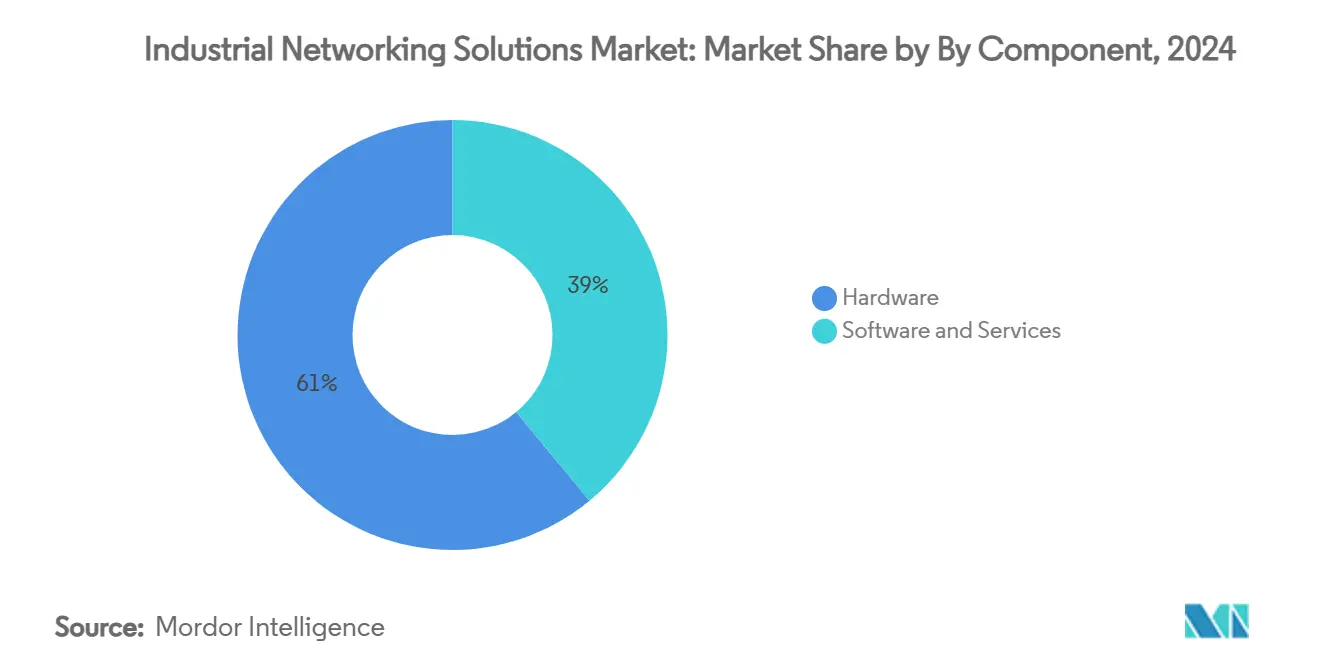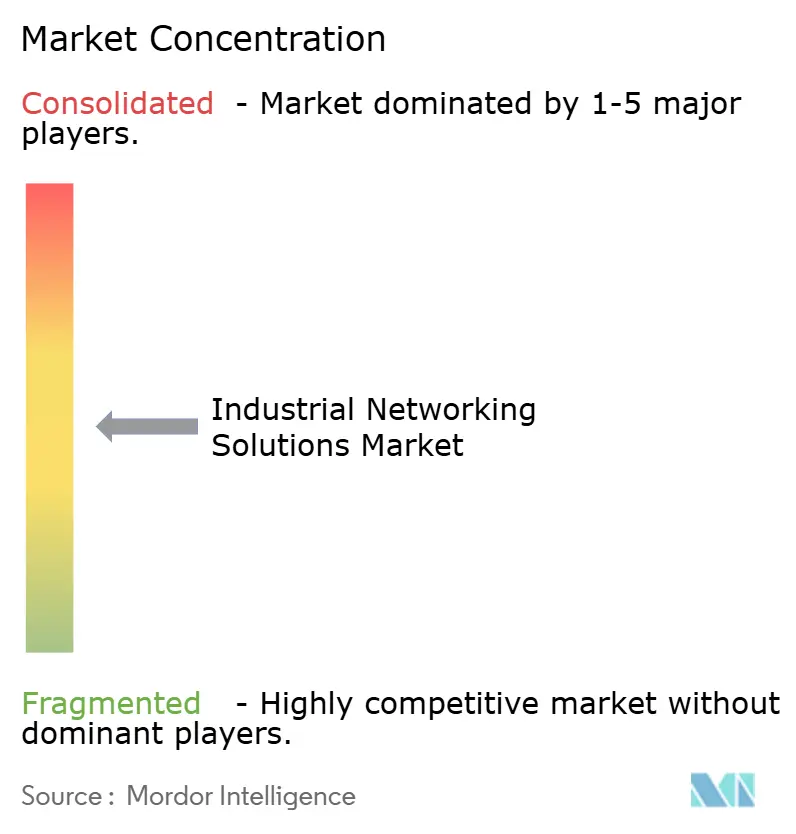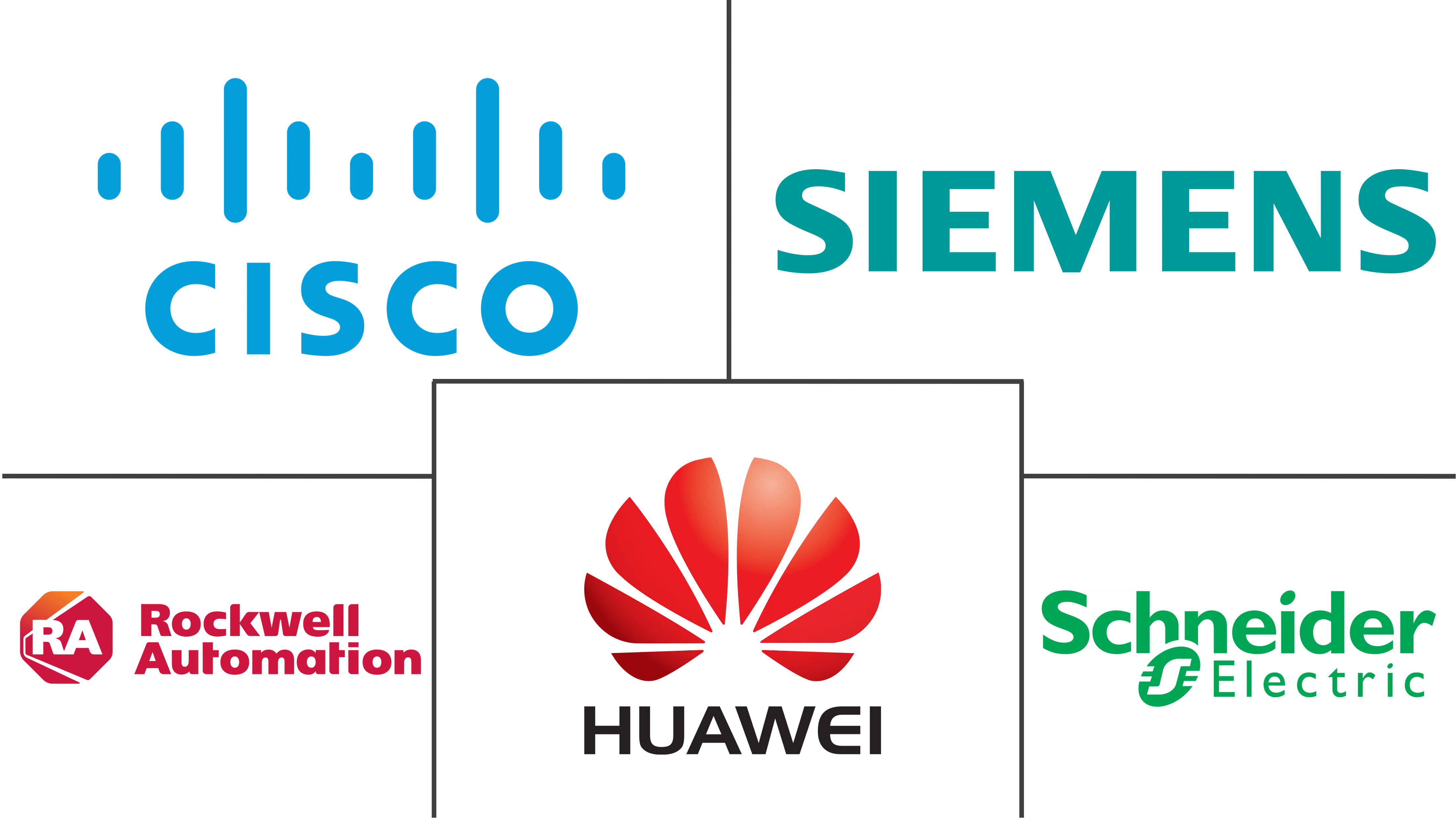Industrial Networking Solutions Market Size and Share

Industrial Networking Solutions Market Analysis by Mordor Intelligence
The Industrial networking solutions market size is valued at USD 30.61 billion in 2025 and is forecast to reach USD 74.22 billion by 2030, advancing at a 19.38% CAGR. The surge reflects rapid convergence of operational-technology assets with enterprise IT networks, creating real-time visibility across increasingly automated production environments. Demand is amplified by a shift from legacy fieldbus to Ethernet-based factory floors that meets sub-millisecond latency targets for autonomous equipment. Private 5G in combination with edge AI is lowering total cost of ownership by up to 30% for heavy industries through predictive maintenance. Government smart-manufacturing stimulus is another catalyst: China alone routed USD 2.8 billion of 2024 funds into industrial networking upgrades. Together, these forces underpin a structurally high-growth trajectory for the Industrial networking solutions market.
Key Report Takeaways
- By component, hardware retained 61.0% of the Industrial networking solutions market share in 2024; software and services are projected to expand at a 22.4% CAGR to 2030
- By type of connectivity, wired solutions held 68.3% of the Industrial networking solutions market size in 2024, while wireless is poised for a 25.9% CAGR through 2030
- By deployment, on-premises accounted for 66.2% of 2024 revenue, but cloud is forecast to grow 24.44% annually to 2030
- By end-user industry, manufacturing led with 31.4% revenue share in 2024; logistics and transportation is the fastest-growing segment at 24.1% CAGR through 2030
- By geography, Asia-Pacific dominated with 34.7% share in 2024; Middle East & Africa is the fastest-growing region at 23.5% CAGR to 2030
- Cisco, ABB, Siemens, and Rockwell Automation together controlled nearly 34% of 2024 revenue, indicating a moderately consolidated competitive field
Global Industrial Networking Solutions Market Trends and Insights
Drivers Impact Analysis
| DRIVER | (~) % IMPACT ON CAGR FORECAST | GEOGRAPHIC RELEVANCE | IMPACT TIMELINE |
|---|---|---|---|
| Rapid shift to IIoT-ready Ethernet-based factory floors | +4.2% | Global, with early adoption in Germany, Japan, South Korea | Medium term (2-4 years) |
| Convergence of OT/IT driving SD-WAN adoption in plants | +3.8% | North America & EU, expanding to APAC | Short term (≤ 2 years) |
| 5G private networks enabling ultra-low-latency control | +3.5% | APAC core, spill-over to MEA mining operations | Medium term (2-4 years) |
| Edge-AI-powered predictive maintenance lowering TCO | +2.9% | Global manufacturing hubs, concentrated in automotive clusters | Short term (≤ 2 years) |
| Government smart-manufacturing stimulus packages | +2.1% | China, Germany, India, with selective programs in Southeast Asia | Long term (≥ 4 years) |
| Open-source Time-Sensitive Networking (TSN) stacks | +1.7% | Global, with technical leadership from IEEE standards bodies | Long term (≥ 4 years) |
| Source: Mordor Intelligence | |||
Rapid Shift to IIoT-Ready Ethernet-Based Factory Floors
Ethernet now powers 73% of new manufacturing network installs, up from 45% in 2020, as factories modernize for machine-vision workloads exceeding 1 Gbps. BMW’s Spartanburg plant runs a private 5G grid that secures 99.9% uptime for vision-driven quality checks. Yet mid-size firms still face USD 2.5 million line-level retrofit costs that slow broad adoption.[1]BMW Group Communications, “Spartanburg Plant 5G Deployment,” bmwgroup.com
Convergence of OT/IT Driving SD-WAN Adoption in Plants
SD-WAN deployments in manufacturing jumped 340% in 2024 as enterprises exported enterprise-security policies to deterministic shop-floor traffic. Hyundai AutoEver cut 60% in network management expense across 47 sites while boosting application performance 35%. Traditional VLAN segmentation lacks the agility required for autonomous mobile robots, so OT-aware SD-WAN is becoming standard.
5G Private Networks Enabling Ultra-Low-Latency Control
Capex for private 5G has fallen 45% since 2023, enabling sub-10 ms wireless round-trip times that match wired determinism. Newmont’s Cadia mine runs autonomous haul trucks underground, raising productivity 15% and cutting safety incidents 40%. CJ Logistics gained 20% warehouse throughput after 5G rollout, underscoring multi-industry relevance.
Edge-AI-Powered Predictive Maintenance Lowering TCO
Local AI inference trims unplanned downtime by up to 50% and maintenance bills by 25% when paired with secure cloud analytics. General Motors’ 15-plant rollout predicts failures 30 days ahead by analyzing vibration and thermal signatures. Continuous-process industries see multimillion-dollar loss avoidance, motivating accelerated adoption despite conservative cultures
Restraints Impact Analysis
| RESTRAINTS | (~) % IMPACT ON CAGR FORECAST | GEOGRAPHIC RELEVANCE | IMPACT TIMELINE |
|---|---|---|---|
| Cyber-physical security skill-gap in brown-field sites | -2.8% | Global, particularly acute in aging industrial regions | Medium term (2-4 years) |
| Proprietary protocol lock-in inflating migration cost | -2.3% | Legacy manufacturing regions in North America and Europe | Short term (≤ 2 years) |
| Semiconductor supply-chain volatility for industrial NICs | -1.9% | Global, with concentrated impact on Asia-Pacific production | Short term (≤ 2 years) |
| Power-density limits in fan-less industrial switch design | -1.4% | Harsh environment applications globally | Long term (≥ 4 years) |
| Source: Mordor Intelligence | |||
Cyber-Physical Security Skill-Gap in Brown-Field Sites
Some 78% of manufacturers cannot find OT-cyber talent, slowing convergence plans. OT-oriented cyber incidents rose 87% in 2024, exposing legacy weaknesses. Cisco and Rockwell’s Digital Skills for Industry initiative aims to train 100,000 APAC professionals to ease the bottleneck.[2]Honeywell Cyber-OT Unit, “2024 OT Threat Report,” honeywell.com
Proprietary Protocol Lock-In Inflating Migration Cost
Average facility migration costs stand at USD 1.8 million, largely due to entrenched single-vendor fieldbus ecosystems. IEEE 802.1 TSN standards promise multivendor inter-op that could temper vendor lock-in and accelerate open-architecture conversions
Segment Analysis
By Component: Hardware Dominance Faces Software Disruption
Hardware commanded 61.0% revenue in 2024, reinforcing the Industrial networking solutions market’s dependence on rugged switches, routers, and access points for harsh sites. Premium fanless switches often list at triple enterprise prices, supporting sustained temperatures and vibration. However, software and services are scaling at 22.4% CAGR, signaling a decisive pivot toward AI-driven network monitoring and subscription models. Siemens’ SIRIUS 3RC7 module embeds software-defined networking at the control layer, evidencing hardware-software convergence. Managed-service providers booked 45% annual growth in 2024 as firms outsourced cyber-hardening and 24×7 monitoring.[3]Phoenix Contact Product Sheet, “Industrial Fanless Switches,” phoenixcontact.com

By Type of Connectivity: Wireless Momentum Challenges Wired Supremacy
Wired Ethernet secured 68.3% share in 2024 owing to deterministic control requirements and Ethernet-APL’s 1,000-m intrinsic-safety reach. Wireless is rising at a 25.9% CAGR as private 5G untethers autonomous robots and accelerates plant re-configuration. Toyota’s material-handling 5G rollout clocked 99.5% reliability while slicing install budgets 60% versus copper. Ultra-low-power modules from Texas Instruments now consume 90% less energy, strengthening battery-powered sensor economics.
By Deployment Type: Cloud Migration Accelerates Despite On-Premises Preference
On-premises kept 66.2% of spending in 2024 due to data-sovereignty and near-zero-latency mandates. Yet cloud is surging at 24.44% CAGR as hybrid architectures marry local control with centralized AI analytics. Microsoft Azure-connected factories increasingly treat the cloud as a single pane of glass for configuration and threat oversight. Schneider Electric’s EcoStruxure platform yields 15% energy savings by fusing edge sensors with cloud optimization, showing pragmatic value beyond mere cost offload.

By End-User Industry: Manufacturing Leadership Faces Logistics Challenge
Manufacturing held 31.4% of revenue in 2024 as automotive players drove high-bandwidth vision and robotics scenarios. BMW and Mercedes plants now depend on Gigabit-class backbones to support continuous defect imaging. Meanwhile, logistics and transportation is the fastest-growing at 24.1% CAGR to 2030. CJ Logistics illustrates the sector’s appetite, posting 20% productivity gains after 5G installs. Mining, oil & gas, and utilities are similarly transforming through autonomous fleets and edge analytics, all contributing to the widening Industrial networking solutions market.
Geography Analysis
Asia-Pacific continues to anchor the Industrial networking solutions market with 34.7% 2024 share, propelled by China’s policy-backed digitalization and Japan’s high-throughput electronics manufacturing ecosystems. The region’s growth outlook remains compelling as India and ASEAN economies scale smart-factory rollouts under Make-in-India and Industry4WRD programs. North America follows as a mature adopter, sustained by USD 800 million of US federal grants that subsidize secure OT-IT upgrades. Europe benefits from stringent cyber-resilience directives and Germany’s EUR 1.2 billion SME fund, fostering broad-based network modernization. The Middle East & Africa region, though smaller, showcases the highest 23.5% CAGR, with Gulf oil majors installing private 5G to operate drilling assets in corrosive deserts and offshore platforms. Latin America’s opportunity hinges on mining and renewable-energy build-outs that demand resilient Ethernet-over-fiber topologies.

Competitive Landscape
Traditional automation suppliers such as Siemens, ABB, and Rockwell Automation are pivoting toward software-centric offerings while networking leaders like Cisco and Ericsson invade OT domains with secure 5G and SD-WAN portfolios. Consolidation intensified in 2025 when ABB bought Siemens’ Wiring Accessories business for USD 150 million, extending smart-building reach. HMS Networks’ USD 345 million purchase of Red Lion Controls highlighted a race for industrial protocol gateways that bridge brown-field assets. Strategic alliances outpace solo R&D: the Cisco-Rockwell pact targets unified OT-IT in Asia-Pacific and underpins cross-selling routers with PLCs. Niche disrupters offering subscription-based, cloud-native management are squeezing margins on commodity hardware. Ethernet-APL, TSN, and open-source stack maturation further flatten vendor moats, compelling incumbents to bundle lifecycle cybersecurity and AI diagnostics.
Industrial Networking Solutions Industry Leaders
-
Cisco Systems, Inc.
-
Huawei Technologies Co., Ltd.
-
Siemens AG
-
Rockwell Automation, Inc.
-
Schneider Electric SE
- *Disclaimer: Major Players sorted in no particular order

Recent Industry Developments
- January 2025: ABB completed the USD 150 million acquisition of Siemens’ Wiring Accessories unit in China, bolstering smart-building reach and channel breadth.
- March 2025: Cisco and Hitachi agreed to replace copper with fiber Ethernet in substations, raising throughput and minimizing cabling complexity.
- March 2025: Rockwell Automation unveiled Emulate3D Factory Test with NVIDIA Omniverse integration for virtual acceptance testing of plant automation.
- February 2025: Cisco and Rockwell launched “Digital Skills for Industry” in India to train 100,000 professionals on OT-IT cybersecurity and networking.
Global Industrial Networking Solutions Market Report Scope
An industrial network solution is an essential part of any automation system architecture as it engages in providing effective means of data exchange and data controllability and flexibility to connect several devices. Generally, communication networks are utilized to enable data communication between computers and other devices. These networks are used in the distribution of multiple products, offer technical support, which needs to be wired and wireless networking systems.
| Hardware |
| Software and Services |
| Wired |
| Wireless |
| On-premises |
| Cloud |
| Automotive |
| Financial Services |
| Manufacturing |
| Telecommunications |
| Logistics and Transportation |
| Mining, Oil and Gas, Energy and Utilities |
| North America | United States |
| Canada | |
| Mexico | |
| Europe | United Kingdom |
| Germany | |
| France | |
| Italy | |
| Rest of Europe | |
| Asia-Pacific | China |
| Japan | |
| India | |
| South Korea | |
| Rest of Asia-Pacific | |
| Middle East | Israel |
| Saudi Arabia | |
| United Arab Emirates | |
| Turkey | |
| Rest of Middle East | |
| Africa | South Africa |
| Egypt | |
| Rest of Africa | |
| South America | Brazil |
| Argentina | |
| Rest of South America |
| By Component | Hardware | |
| Software and Services | ||
| By Type of Connectivity | Wired | |
| Wireless | ||
| By Deployment Type | On-premises | |
| Cloud | ||
| By End-User Industry | Automotive | |
| Financial Services | ||
| Manufacturing | ||
| Telecommunications | ||
| Logistics and Transportation | ||
| Mining, Oil and Gas, Energy and Utilities | ||
| By Geography | North America | United States |
| Canada | ||
| Mexico | ||
| Europe | United Kingdom | |
| Germany | ||
| France | ||
| Italy | ||
| Rest of Europe | ||
| Asia-Pacific | China | |
| Japan | ||
| India | ||
| South Korea | ||
| Rest of Asia-Pacific | ||
| Middle East | Israel | |
| Saudi Arabia | ||
| United Arab Emirates | ||
| Turkey | ||
| Rest of Middle East | ||
| Africa | South Africa | |
| Egypt | ||
| Rest of Africa | ||
| South America | Brazil | |
| Argentina | ||
| Rest of South America | ||
Key Questions Answered in the Report
What is the current size of the Industrial networking solutions market?
The Industrial networking solutions market stands at USD 30.61 billion in 2025 and is projected to reach USD 74.22 billion by 2030 at a 19.38% CAGR.
Which component dominates spending?
Hardware maintains leadership with 61.0% 2024 revenue, though software and services are growing faster at 22.4% CAGR.
How fast is wireless connectivity growing relative to wired?
Wireless solutions are forecast to expand at 25.9% CAGR to 2030, outpacing wired Ethernet, which nevertheless retains the larger share.
Which region offers the highest growth potential?
The Middle East & Africa region shows the fastest outlook at 23.5% CAGR, driven by oil-and-gas modernization and smart-city projects.
What is the main barrier to wider adoption?
A global shortage of OT-cybersecurity skills in brown-field facilities is slowing deployments and subtracting an estimated 2.8 percentage points from forecast CAGR.
How are companies addressing proprietary protocol lock-in?
Vendors and standards bodies are advancing open TSN and Ethernet-APL specifications to enable multivendor interoperability and reduce migration costs.
Page last updated on:



